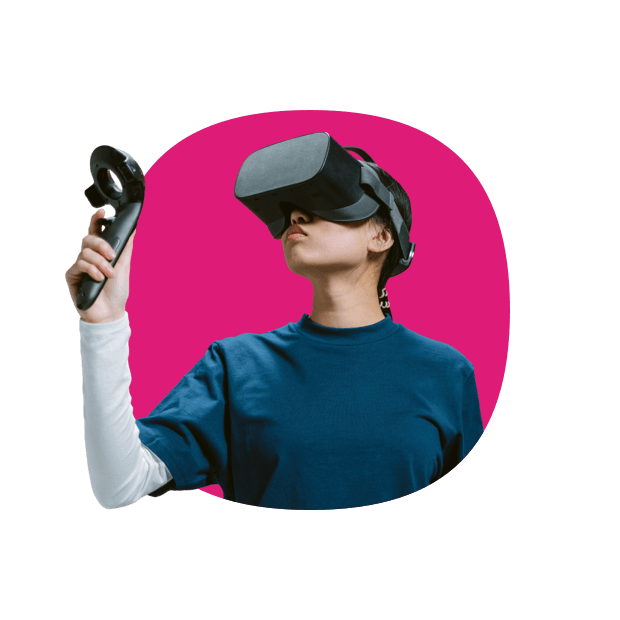“Virtual reality is a medium for the extension of body and mind… constructed by the senses and only exists in the minds of users.” You may be thinking this sounds revolutionary, right? But it was actually published all the way back in 1993 by Frank Biocca and Mark Levy.
The point we’re making is, like most technology that makes major waves in the news, virtual reality isn’t really a new concept at all. What has changed is the way we connect with the world around us and the technology we use to do it, so what does the future of VR look like? Let’s take a look at some of the key VR trends.
VR adoption and popularity
Globally, over a quarter of consumers say they’re excited about virtual reality. But that excitement hasn’t translated into purchase behavior, with only 5% of consumers actually pulling the trigger.
It’s hard to speak about the future of VR without touching on the metaverse, which at the time, felt like a completely game-changing phenomena. Excitement over the metaverse has fallen 20% year-on-year, so we’re very much on the other side of the hype bubble that took over tech news in 2022: a vision of co-creative virtual worlds where we’d buy virtual clothes, have meetings, and socialize. Roblox gives us great insight into metaverse trends that have caught brands’ attention, but it was the release of the Apple Vision Pro in 2024 that gave consumers a real glimpse into the future of VR.

Apple’s entry into new product categories often means one thing. The Apple Watch was released in 2015, and since then ownership of smartwatches has grown year-on-year. Does that mean the Apple Vision Pro will kick off a new VR trend? Well, we can look at other technologies to see how something might shift from an emerging trend, to mainstream adoption.
Smartwatch ownership accelerated during the pandemic. As people swapped gym workouts with home exercise and local runs, they found comfort in tracking their health stats. Then there’s the lower price point which makes them a more accessible choice versus traditional luxury watches.
Today, there are more VR headset owners in markets like North America than there were smartwatch owners back in 2015. While VR isn’t about tracking steps, people are willing to pay high prices for the unique digital experiences these devices offer, and those that don’t own them are curious to see what it’s like.
Take YouTuber MKBHD’s review of the Apple Vision Pro as an example. It hit 26 million views in just four months – the second most popular video ever released on his channel. Despite the initial excitement, the buzz around VR devices has faded. Now, the challenge lies in proving their value, creating more accessible price points, and proving their use cases.
VR users are interested in more than gaming
We know there are different motivations to use VR headsets, but if you thought these early adopters would just be a bunch of gamers, you’d be wide of the mark.

Just to make it clear, VR owners are into gaming. Globally over half say they own a games console, and they use them not just for gaming, but surfing the web too. They’re also super active on Reddit, being over four times more likely than average to use the platform to create posts, and three times more likely to join communities and keep up-to-date with the news.
But then there’s the enterprise users. They’re over three times more likely to have gone on over three international business trips in the last year and to use American Express payment services. They’re also over three times more likely to have started a LinkedIn learning course, or even clicked on sponsored ads on the platform.
The point is, looking beyond demographics helps you to explore the diversity within an audience, and VR owners are a more diverse crowd than you’d imagine.
How are consumers already using VR?
It’s no surprise that gaming is VR users’ primary motivation to own one, but you really need to look at the bigger picture. Not many gamers have actually bought into this tech.

While gaming currently dominates, the market is expanding from niche audiences like hardcore gamers, to productivity and mixed-reality for enterprise users and casual applications. That’s why the top reasons for using a VR headset among non-console owners is for entertainment, and if the release of the Apple Vision Pro was anything to go by, it caught consumers’ imagination.
While we’re unlikely to see Vision Pro usability at a Meta Quest 3 price point for a number of years, there are plenty of audiences who this tech will still appeal to. Besides a general lack of interest, the most common reasons for not buying into the tech is the high cost, and limited use cases. With Apple reportedly focusing on a cheaper successor to the Vision Pro, consumers still need proof that the tech is worth the investment before they make the leap.
Mapping out the VR market
In order to understand the state of VR trends, we need to have a look at the market landscape. To do this, we’ve considered some of the most popular VR devices on the market today, and how they may appeal to different consumer groups.

Consumer: Designed primarily for casual users, typically easier to use, more affordable, and require less technical setup. Often marketed towards the general public for everyday use.
Professional: Designed for professional or enterprise use. Typically have higher specifications, more advanced features, and a higher price point. Used for professional applications such as design, simulation, or enterprise-level productivity.
Gaming: Optimized primarily for gaming. Focus on features such as high refresh rates, immersive graphics, and responsive controls to provide an optimal gaming experience.
Productivity/Mixed Reality: Optimized for productivity tasks and mixed reality applications. Includes features such as high-resolution displays for detailed work, AR capabilities, and tools for collaboration, design, and other professional uses.
Brands are positioning themselves in the market with different priorities. The Meta Quest series are a mix of performance and affordability, popular for both casual and immersive gaming experience, and high agency users. The PlayStation VR2 is an out and out gaming device, for users seeking high-quality VR gaming without the need for a high-end PC. Then the Apple Vision Pro positions itself as a premium device for casual browsing and professional use, integrating seamlessly with the Apple ecosystem.
The thing with the Apple Vision Pro is that it’s not pitched as a ‘new’ product but as an extension of an established tech ecosystem, it provides much greater immersion and for many, familiarity. You could draw parallels with the release of the first iPhone, a premium offering that kicked off the smartphone boom in 2007. What’s more difficult to predict is whether this will lead to broader adoption.
Profiling prospective VR consumers
With only 4% of consumers planning to buy a VR headset in the next 12 months, competition is high, making it even more important to understand who these prospective buyers might be. With the technology far from reaching mass adoption, we’ve used the perceptual map above to create four consumer profiles based on the most likely demographics to engage with VR: casual gamers, hardcore gamers, tech professionals, and enterprise users.
Note: Stand out behaviors are what makes the audience most distinctive when compared to the average consumer
Casual gamers
Demographic: Consumers aged 16-34 with an interest in gaming, they use a personal PC/desktop or games console to play games at least once a week.
Stand out brand discovery channels: Ads seen in video/mobile games, vlogs, ads on music-streaming services.
Stand out brand qualities desired: Young, trendy/cool, bold.
Stand out brand interactions in the last month: Played a branded game, downloaded/used a branded app, watched a video made by a brand.
Stand out VR purchase drivers: Quality of graphics, availability of content, reviews/recommendations from friends, family, or colleagues.
Profile
Casual gamers tend to be younger and predominantly male. Digital touchpoints are key to brand interactions, standing out for discovering products and services through ads in video games, vlogs, and music-streaming services. Their gaming interest translates to the things most important to them when considering purchasing a VR headset/device: quality of graphics, availability of content, and recommendations from their close network.
Hardcore gamers
Demographic: Consumers aged 16-40 with an interest in gaming, they use a personal PC/desktop or games console to play games on, and play on their console for at least three hours a day.
Stand out brand discovery channels: Ads seen in video/mobile games, ads on music-streaming services, ads/sponsored content on podcasts.
Stand out brand qualities desired: Funny, bold, exclusive.
Stand out brand interactions in the last month: Played a branded game, downloaded/used a branded app, uploaded a photo/video to a brand’s social network page.
Stand out VR purchase drivers: Delivery/collection time post purchase, availability of content, reviews/recommendations from influencers and celebrities.
Profile
Hardcore gamers play on their consoles for multiple hours a day, and like casual gamers, stand out for discovering brands through digital touchpoints like video games, music-streaming services, and through podcasts. They care most about features and availability, as the post-purchase collection time, availability of content, and reviews from influencers and celebrities, are their standout considerations for buying a VR device.
Tech professionals
Demographic: Consumers aged 25-44, who work in education, IT/telecommunications and software development/computer engineering roles. They tend to have an undergraduate or postgraduate degree.
Stand out brand discovery channels: Ads seen in virtual spaces (VR/AR), vlogs, posts or reviews from expert bloggers.
Stand out brand qualities desired: Innovative, smart, exclusive.
Stand out brand interactions in the last month: Interacted with a brand on a messaging app, used a company’s live-chat service on a website, provided ideas for a new product/design.
Stand out VR purchase drivers: Brand reputation, quality of graphics, brand name.
Profile
Tech professionals tend to be ‘younger’ professionals who are highly educated and in technical occupations. They stand out for interacting with brands through messaging services and online chats, and actively provide ideas for new products. As their use for VR headsets is for productivity and mixed reality, the most important purchase considerations are the brand reputation, quality of graphics, and the brand name.
Enterprise users
Demographic: Consumers aged 30-50. They work in healthcare & medical services, engineering, IT/telecommunications and software development/computer engineering roles. They’re confident using new technologies.
Stand out brand discovery channels: Ads seen in virtual spaces (VR/AR), posts or reviews from expert bloggers, personalized purchase recommendations on websites.
Stand out brand qualities desired: Exclusive, innovative, smart.
Stand out brand interactions in the last month: Shared a brand’s post on a social network, used a company’s live-chat service on a website, provided ideas for a new product/design.
Stand out VR purchase drivers: Brand reputation, brand experience (i.e. a brand they’ve used before), quality of graphics.
Profile
Enterprise users tend to be middle-aged, tech-confident, and in advanced technical occupations. They value the perspective of others when discovering new brands, they want brands to be innovative, and they actively provide feedback on product/service development. With that, brand reputation, their experience with the brand, and the quality of graphics are their stand out considerations for purchasing a VR device.
So… what is the future of VR?
As we’ve seen with the Meta Quest Pro and Apple Vision Pro, the future of VR is more than gaming. While gamers are the early adopters, we’ll begin to see more utility from enterprise users, and more avenues for consumers looking for enhanced entertainment experiences. But as we see this technology today, the use cases are limited, and the cost is putting off those who might consider trying virtual experiences. VR is still looking for its killer app to hook in those curious to try it, but Apple’s will get app developers and advertisers minds racing and the emerging opportunity.
Check out our Consumer Tech data set
Find out more





.webp?width=495&height=317&name=pink_thumb_graphs%20(1).webp)
.webp?width=495&height=317&name=pink_thumb_letter%20(2).webp)
